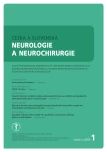Encephalocele in the Czech Republic – incidence, prenatal diagnostics and international comparison
Authors:
A. Šípek- 1 4; V. Gregor 1,2; J. Klaschka 5,6; M. Malý 5,7
; Jitka Jírová 8
; Natálie Friedová 1,9
; A. Šípek jr. 1,4,9
Authors‘ workplace:
Oddělení lékařské genetiky, Thomayerova nemocnice, Praha
1; Oddělení lékařské genetiky, Sanatorium Pronatal, Praha
2; Oddělení lékařské genetiky, Gennet, Praha
3; Ústav lékařské genetiky 3. LF UK, Praha
4; Ústav informatiky Akademie věd ČR, Praha
5; Ústav biofyziky a informatiky 1. LF UK, Praha
6; Státní zdravotní ústav, Praha
7; Ústav zdravotnických informací ČR, Praha
8; Ústav biologie a lékařské genetiky 1. LF UK a VFN v Praze
9
Published in:
Cesk Slov Neurol N 2021; 84/117(1): 66-70
Category:
Original Paper
doi:
https://doi.org/10.48095/cccsnn202166
Overview
Aim: The aim of this study was to analyse the total incidence of an encephalocele and to evaluate the effectiveness of its prenatal diagnostics in the Czech Republic.
Methods: We used the official data from the National Registry of Congenital Anomalies kept within the Register of Reproductive Health in the Institute of Health Information and Statistics of the Czech Republic during the time period 1994–2015. The second source were data on prenatal diagnostics collected under the guidance of the Society of Medical Genetics and Genomics CMA JEP. In our work, we analysed the annual frequencies and their changes in both born children and prenatally-diagnosed cases. We also analysed weeks of pregnancy in prenatally-diagnosed cases.
Results: During the 1994–2015 time period, a total of 279 cases of encephalocele were diagnosed in the Czech Republic. Among those, 216 cases were prenatally diagnosed (and electively terminated) due to a serious developmental defect, while 63 cases were reported in newborns. In relative numbers (per 10,000 live births) the total incidence of encephalocele was 1.24 (0.96 in prenatally-diagnosed cases and 0.28 in births). During the selected time period, the frequency of prenatally-diagnosed cases increased significantly (P < 0.001), but after 2008 the growth stopped and the level remained roughly the same. The number of encephalocele in births decreased slightly, but they did not show a statistically significant trend (P = 0.585).
Conclusion: The effectiveness of prenatal diagnostics of encephalocele increased significantly during the selected time period. This trend can be observed especially till 2008; in the 2009–2015 time period, the changes were not significant anymore.
Keywords:
encephalocele – prenatal diagnostics – nervous system malformations – Czech Republic
Sources
1. Horn F, Smrek M, Babala J et al. Kraniálne defekty neurálnej rúry. Cesk Slov Neurol N 2010; 73/106 (6): 706–710.
2. Detrait ER, George TM, Etchevers HC et al. Human neural tube defects: developmental biology, epidemiology, and genetics. Neurotoxicol Teratol 2005; 27 (3): 515–524. doi: 10.1016/j.ntt.2004.12.007.
3. Hall JG, Friedman JM, Kenna BA et al. Clinical, genetic, and epidemiological factors in neural tube defects. Am J Hum Genet 1988; 43 (6): 827–837.
4. Kondo A, Matsuo T, Morota N et al. Neural tube defects: risk factors and preventive measures. Congenit Anom (Kyoto) 2017; 57 (5): 150–156. doi: 10.1111/cga.12227.
5. Padmanabhan R. Etiology, pathogenesis and prevention of neural tube defects. Congenit Anom (Kyoto) 2006; 46 (2): 55–67. doi: 10.1111/j.1741-4520.2006.00104.x.
6. Arifin M, Suryaningtyas W, Bajamal AH. Frontoethmoidal encephalocele: clinical presentation, diagnosis, treatment, and complications in 400 cases. Childs Nerv Syst 2018; 34 (6): 1161–1168. doi: 10.1007/s00381-017-3716-3.
7. Hunter AG. Brain and spinal cord. In: Stevenson RE, Hall JG (eds). Human malformations and related anomalies. 1st ed. Oxford: Oxford University Press 2005 : 715–756.
8. Calda P. Ultrasonographic and biochemical markers in prenatal detection of Down‘s syndrome and neural tube defects. Funct Dev Morphol 1992; 2 (2): 135–137.
9. Sepulveda W, Wong AE, Andreeva E et al. Sonographic spectrum of first-trimester fetal cephalocele: review of 35 cases. Ultrasound Obstet Gynecol 2015; 46 (1): 29–33. doi: 10.1002/uog.14661.
10. Šípek A, Gregor V, Horáček J et al. National Registry of Congenital Anomalies of the Czech Republic: commemorating 50 years of the official registration. Cent Eur J Public Health 2014; 22 (4): 287–288. doi: 10.21101/ cejph.a4201.
11. Hardin JW, Hilbe JM. Generalized linear models and extensions. 3rd ed. College Station, CA, USA: Stata Press 2012.
12. Šípek A, Horáček J, Gregor V et al. Neural tube defects in the Czech Republic during 1961–1999: incidences, prenatal diagnosis and prevalences according to maternal age. J Obstet Gynaecol 2002; 22 (5): 501–507. doi: 10.1080/0144361021000003636.
13. Šípek A, Gregor V, Horáček J et al. Prevalence vybraných vrozených vad v České republice – vývojové vady centrálního nervového systému a zažívacího traktu. Epidemiol Mikrobiol Imunol 2015; 64 (1): 47–53.
14. EUROCAT. Encephalocele – Data prevalence table. [online]. Available from URL: https: //eu-rd-platform.jrc.ec.europa.eu/eurocat/eurocat-data_en.
Labels
Paediatric neurology Neurosurgery NeurologyArticle was published in
Czech and Slovak Neurology and Neurosurgery

2021 Issue 1
Most read in this issue
- Frontotemporal dementia
- Encephalocele in the Czech Republic – incidence, prenatal diagnostics and international comparison
- COVID-19 and stroke
- Carotid endarterectomy after intravenous thrombolysis and mechanical thrombectomy
